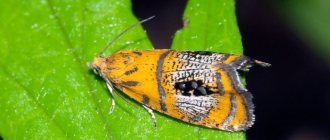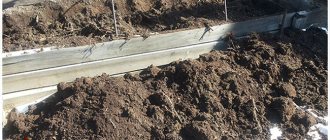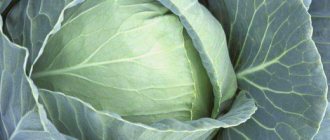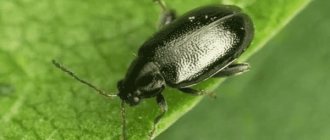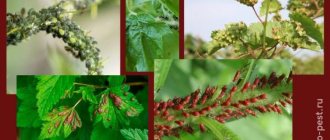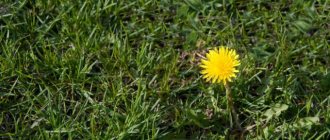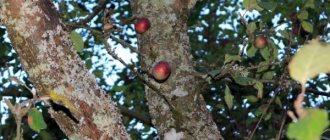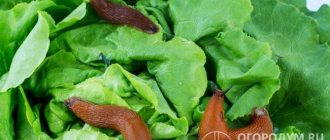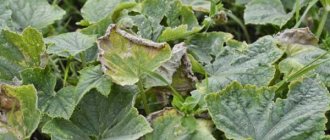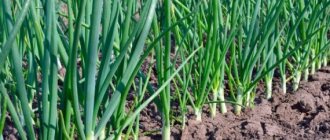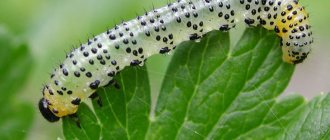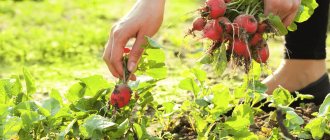With the onset of spring, the summer season begins.
The first thing to do before the trees and shrubs wake up is to treat them against all sorts of diseases and pests. Dear readers!
For you, we have created communities on social networks in which useful articles and interesting ideas are published several times a day! Subscribe and receive useful content in a convenient format! In this article we will talk about the timing of the work, as well as the most important nuances of such agrotechnical measures.
Why do you need spring gardening?
During the summer season, the garden and the cultivated plants growing in it are regularly exposed to insect pests and pathogenic microorganisms (fungi, bacteria, viruses).
Even if you regularly treat your plantings with insecticides and fungicides, some of the painful microflora, as well as egg clutches and larvae of pests, inevitably remain in your garden.
With the onset of cold weather, they all look for shelter for the winter. Bark, buds, and old, unfallen leaves become such shelters.
When the temperature rises in the spring, pests wake up along with the plants and immediately begin to feed on the sap and other parts of trees and shrubs.
Early spring treatment of the garden allows you to destroy most of these pests in the early stages and prevent the development of many diseases in the future.
Treating the garden in early spring against pests and diseases
Rate
5
Spring is the most important time of year for fruit trees. At this time, plants must quickly regain strength after wintering and stock up on food for fruiting. But along with the spring sun, not only plants wake up, but also parasitic insects. And if you don’t treat the garden in a timely manner, you shouldn’t count on a good harvest in the new season.
How many times does a garden need to be cultivated in spring?
A total of four garden sprayings against insects and infections are recommended:
1. Before the start of sap flow and swelling of the buds.
2. At the stage of unopened buds - spraying along the “green cone”.
3. Before flowering - in the “bud release” phase.
4. Immediately after flowering.
Each of the 4 treatments requires careful selection of chemicals, taking into account the growing season of the plants. For example, more aggressive preparations can be used in early treatment compared to means for treating the garden during the budding period.
Preparatory work
Before you start processing the garden, you need to prepare, as they say, the “front of work”, for this you need:
- clean the garden area from last year’s grass, fallen leaves, and other plant debris in which pests overwinter;
- burn them and use the ash to make compost or as natural fertilizer;
- pruning trees and shrubs, if necessary, also dispose of pruned branches; they can be sources of fungal diseases and wintering grounds for harmful insects;
- If possible, dig up the soil around fruit trees, near bushes and in the garden plot;
- clean tree trunks of dried bark, whitewash the lower part and thickest branches with lime mortar, collect the peeled bark and burn it.
After completing all of the above work, your garden will be completely ready for processing, which must be done before the first buds bloom on the trees.
We examined all types of work in the spring garden in more detail in the article: Spring work in the garden and vegetable garden - the procedure in detail!
First treatment of trees in early spring
The first purpose of garden treatment is to prevent fungal and other plant diseases.
The very first treatment of the garden is considered perhaps the most important. It is better to destroy pests and disease carriers that have overwintered in the bark and tree trunk soil preventively, before they have yet recovered from hibernation and begun their dirty work. That is why it is necessary to carefully treat cracks in the bark and the soil around the tree trunk, that is, the wintering area of the larvae.
For the first spraying of the garden, aggressive chemicals containing copper are usually used. In the second half of March - early April, when the garden is sprayed for the first time, the trees have not yet begun the period of intense sap flow, so it is impossible to harm them.
When to spray?
At the stage of closed, dormant buds, as they say, “on the bare tree,” when there are still no signs of awakening. At this time, spores of fungal diseases may already begin to fly away. It is believed that it is advisable to carry out the treatment when the average daily air temperature reaches 5 degrees Celsius.
What to spray with?
The first spraying is carried out against diseases, since the insects have not yet had time to become active - they simply have nothing to eat (the buds have not opened). Spraying will protect the garden from various types of rot, moniliosis of stone fruit crops, and from scab on apple and pear trees. The drugs used are: Bordeaux mixture 3%, urea, iron sulfate, copper sulfate, copper-containing preparations Hom, Oxychom, fungicides Horus, Skor, Farmayod, Abiga-pik, Nitrafen, Rayok and insecticides “30 plus”, “Profilaktin”.
Before the buds open, treatment against the wintering stages of pests is important, and here modern drugs “30 plus” and “Profilaktin” come to the rescue, as well as the proven complex product “Nitrafen”, which works against both pests and diseases.
30 plus
Insectoacaricides are preparations of chemical or biological origin intended to simultaneously combat harmful insects and mites.
I would like to draw your attention a little to the drug “30 plus”. This is one of the best broad-spectrum insectoacaricides for early spring treatment of garden and ornamental plants against pests: whiteflies, aphids, moths, mites, leaf rollers, scale insects, flower beetles, etc. The range of applications is quite wide. The insecticide is especially effective against wintering larvae and egg laying, which is why it is also called “Spring garden washing of wintering insects.”
At what temperature are trees sprayed?
There are several methods for treating trees and bushes, but the most effective is spraying.
You can carry out the procedure from the very first warm days, when the thermometer has barely crossed the zero mark.
Traditionally, manufacturers indicate +3+5 degrees as the minimum recommended temperature for working with drugs and carrying out treatments.
NOTE! This should be a stable temperature, and not a one-time thaw in the middle of frosty days.
Treating trees with copper sulfate
Copper sulfate is similar in action to Bordeaux mixture, but it does not help well against pests. In order for the drug to be of greater benefit, some kind of broad-spectrum insecticide is usually added to it. If there is no such product on sale, you can simply alternate treatment with copper sulfate and spraying with insecticides - this will also be effective.
Copper sulfate itself copes with curliness, coccomycosis, moniliosis, phyllosticosis, clusterosporosis, scab and other diseases. It is not only possible, but even recommended to process apple, pear and plum trees first.
But copper sulfate also has one big drawback - toxicity. When working with it, protective suits and gloves are used. It is important to prevent it from getting into a pond, fountain, or tank of water from which animals, people, and fish drink. The working solution is prepared from 100 g of copper sulfate and 10 liters of water. Stronger concentrations can be dangerous for trees.
Stages of spring processing
Unfortunately, there is no such thing that you can spray the bushes in your garden once in early March and forget about pest prevention and control until next year.
Not all pests and pathogenic microorganisms die; they return, migrate from neighboring areas, are carried by the wind, etc.
Therefore, protecting the garden is a long process. All spring processing can be divided into 4 stages.
How to spray trees in the spring before buds open
Treatment before bud break is carried out in 2 stages:
- In the very early spring, when the trees and bushes are still dormant;
- When the plants woke up and the buds swelled, but did not bloom yet.
In the very early spring, we destroy insects that were hiding from winter frosts in the bark. At this stage, you can scald the currants with boiling water, and also treat them with Preparation 30plus, iron sulfate, and Nitrofen.
ON A NOTE! Processing at this stage is considered the most important. But the drug must work at low temperatures (+3+5).
“Along the green cone”
This is the stage when the first tips of the leaves are just emerging from the bud. This time passes very quickly, especially in warm spring. Therefore, you need to work quickly.
At this time, we are fighting fungal diseases (scab, moniliosis) and various rots. Of the insects at this time, the greatest danger is bud mites.
Bordeaux mixture or copper sulfate are effective, as well as the chemicals Skor, Enzhio, Hom, Decis, Topaz, Strobi, Aktara, Aktellik, Nitrafen, etc.
How to treat a garden during flowering
NOTE! Most treatments during flowering are prohibited, as they can kill bees, which are the main pollinating insects.
Treatment can only be carried out at the “pink bud” stage, that is, at the first stage of flowering, when buds are just forming.
At this stage, preventive treatment against fungi and insect pests continues. You can use Karbofos and Bordeaux, as well as Fitoverm, Fitosporin, Iskra, Aktara, Horus, etc.
By the ovaries after flowering
When the flowers fall off, the ovaries of future fruits remain in their place. This is the last stage of spring processing, although in the northern regions of our country this stage can begin in the summer.
At this stage, active pest control begins. You can spray with colloidal sulfur, Bordeaux mixture, urea, Fitosporin and various insecticides. For example, Skor, Aktara, Konfidor, Decis, Fufanon, etc.
Processing times
Spring processing is divided into several periods.
- The trees and bushes are still sleeping, have not recovered from their winter dormancy. The branches are bare. Gardeners need to carefully examine trees and shrubs, because in the first month of spring, plants may be affected by diseases: scab and moniliosis. Viruses need to be fought in March by first cleaning the branches and trunk. If you don’t brush, the effectiveness of the drugs decreases significantly. The air temperature in March is already above 0, so it’s time to carry out work.
- The second period is to strengthen the protection of trees from pests. It’s the beginning of April, the buds are swelling, a little more and tender leaves will hatch. It is important to save the buds from the larvae that drink the sap of the buds, thereby interfering with the development of the fruit tree or shrub. If you skip this treatment, the buds simply will not open and die.
- The third very important step is in May. After the flowering period is over, you need to spray the trees and shrubs, if necessary. It is necessary to check whether garden crops are infected, and act immediately at the first sign. Typically, this treatment occurs two to three weeks after the flowering period.
Spring pruning of fruit trees and shrubs in early spring
How to carry out treatment and spraying, step-by-step instructions
Step 1. Carry out preparatory work: remove debris, tear off old leaves, prune (if necessary). All this must be burned, since all this garbage is the habitat of pests.
Step 2. Clean lichens and mosses from the trunks.
Step 3. Dig up the soil in the tree trunk circle or loosen it.
Step 4: Whitewash the trees. In principle, whitewashing can be done after treatment if you are afraid of washing off the applied lime. If you are using permanent paint, you can whitewash the trunks first.
Step 5. Prepare the working solution, following all the instructions and safety precautions.
Step 6. Treat trees and shrubs. Start spraying from the crown. The last thing to process is the trunk and the ground around it.
IMPORTANT! Plants should be sprayed early in the morning or in the evening. On cool and cloudy (but not raining) days, you can work during the day.
Stage 4 “Digging and processing of tree trunk circles”
Digging and processing of tree-trunk circles
Next, the tree-trunk circles of trees and shrubs are dug in. This is a simple and necessary stage of work, which is carried out primarily to improve soil aeration.
To prevent phytopathogens, it is advisable to treat the soil around the tree trunks with biological preparations (Fitosporin, Gamair, Alirin-B, etc.) to disinfect the soil and saturate it with beneficial microorganisms. Overwintered insects and their larvae can be shed with a 0.5 kg solution prepared according to a simple recipe. carbamide (urea) and 10 l. water.
Read more: “TOP 5 best biological products for soil disinfection”
Spraying features
Depending on the type of plant, there are some features that greatly simplify the spraying procedure.
For mature fruit trees
For an adult tree, half a bucket of the entire solution is spent. The sprayer must be powerful enough to cover the top of the crown. Fine spraying may not be effective because... the active substance will evaporate before it reaches the leaves.
For young plants
A young plant can even be sprayed with a regular spray bottle. Up to 1.5 liters of solution is spent on a tree or shrub. If the seedling is very young, then the concentration of the drug can be reduced so as not to burn the plant. Young seedlings can also be treated with fine spraying.
For old bushes
Old bushes are usually very spreading with a large number of shoots. First of all, they need to be pruned, removing dried and diseased branches. Then, so that less solution is wasted, the shoots can be collected into a “stack,” tied and sprinkled. But this must be done carefully so as not to break off the branches.
Recommendations
- Carry out the treatment if the weather forecast is favorable for the next 3-5 hours, repeat if necessary.
- The consumption rate of the working solution is at least 1-1.5 liters/shrub and 5-6 liters/mature tree.
- When carrying out work, use PPE and follow generally known personal safety measures.
- Spring preparation of the garden does not allow you to waste time; all work must be carried out on time.
In addition, see the separate material “Processing GRAPES from diseases and pests - STEP-BY-STEP plan (stages, timing, preparations).”
Spraying with chemicals
Spraying in spring can be carried out using various means. If the garden is not heavily infected, then you can use preventative drugs: Bordeaux mixture, copper and iron sulfate.
How to treat a garden with Bordeaux mixture
Bordeaux mixture can be used twice. The first time is before the buds open. At this time, treatment is carried out with a 3% solution. The second time is after the buds open. For example, at the stage of a green cone or a pink bud. When exactly to spray depends on when the first treatment was carried out.
Copper sulfate
Copper sulfate is an effective means for spring garden treatment. In its properties it is very similar to Bordeaux. Both drugs are based on copper sulfate.
By the way, therefore, there is no need to treat with copper sulfate and Bordeaux mixture. It is better to choose one remedy. The fact is that copper accumulates in the ground.
Copper sulfate cannot be diluted in metal containers. Use plastic buckets or glass bottles.
Copper sulfate is also used in 2 treatments: 3% before swelling of the buds, 1% after.
ON A NOTE. Copper (and iron) sulfate dissolves better in hot water.
Iron sulfate
Although iron sulfate is more effective in the fall, it can also be used for preventive spraying in the spring.
This preparation is also suitable for eradication treatment. Helps against lichens, mosses, and also has a negative effect on some larvae.
IMPORTANT! Both iron and copper sulfate should not be mixed with solid soap. Only with liquid or dishwashing detergent.
The first spring spraying is the most important
In my opinion, the first spraying of the garden is the most important, and it is absolutely worth doing. It is carried out in early spring before the buds begin to swell on plants at an average daily temperature of approximately +4. At this moment, the tree is still sleeping, just as overwintered pests and disease spores sleep. And you can use drugs in fairly strong concentrations without fear of causing damage to plants.
It’s just worth taking a close look at different plants; not all of them are in the same phase. For example, if the apple tree is still sleeping, then the buds on the blackcurrant are already swollen and strong solutions can harm it, simply burn it. Therefore, we approach the first spraying very carefully.
What to use? The classic, popular solution for a hundred years is “Bordeaux mixture”. This is a mixture of two aqueous solutions of lime and copper sulfate. Some people prepare it themselves (and this needs to be done correctly), others buy a ready-made kit for preparation (“Bordeaux mixture”) at a garden store. For the first spring spraying, you should use 3% Bordeaux mixture.
You can use iron sulfate by diluting it in water (300-500 grams per 10 liters). What does concentration depend on? On the degree of infestation of your garden. For a weak infection, 300 grams per bucket of water is enough; for a clearly diseased garden, it is better to dissolve 500 grams.
Some gardeners use the good old Nitrofen for the first spring spraying. In my opinion, this is not worth doing. It is “kind” in the sense of its effectiveness, but it is not at all “kind” to our health.
Much more interesting is the recently popular concentrated solution of urea (carbamide). Take approximately 700 grams of urea per 10 liters of water. You can also add 50 grams of copper sulfate. This solution effectively fights both overwintered insect pests and spores of many diseases.
This solution has two additional “bonuses”. On the one hand, it slightly slows down the growing season (7-10 days), which can protect flowers from spring frosts. On the other hand, it is a nitrogen fertilizer, which is what our plants need in the spring. These are the properties that seem to contradict each other, and yet work.
There is a good option - “Drug 30-v”. It is considered safe for us and the environment because it simply creates a film on the surface of the sprayed plant, and pests do not have the opportunity to “breathe.” But it is worth remembering that it fights insect pests, but not diseases. And it is worth using it in those gardens that suffer specifically from pests.
There are other drugs... When choosing one or another, the main criterion is whether it is suitable for early spring and processing at low temperatures (let me remind you, +4 degrees).
Treatment with various drugs
Insecticides and fungicides are highly effective in controlling unwanted guests in your garden. Now there are many different drugs. We will focus only on the most popular and effective ones.
Nitrafen
An old proven drug. Quite toxic. Destroys ticks, scale insects, aphids, caterpillars and other pests.
Prepared at the rate of 1 kg of Nitrafen paste per 50 liters of water. Consumption for 1 large adult tree (apple tree, apricot or pear) – up to 30 liters. For a medium-sized tree - about 10 liters.
Drug 30 plus
This is an effective remedy against scale insects, mites, aphids and a number of other pests. It should be applied in early spring. Drug 30 plus is a fairly gentle remedy and it is better to use it when there is no mass infection. If your garden suffers from regular insect infestations, then it is better to use stronger products.
Hom
Remedy for fungi and bacteria. Prepared in the proportion of 20 g per 5 liters of water. This is the norm for 1 tree. The drug is old, proven and quite effective.
Topaz
An effective remedy for rot and powdery mildew. 1 ml of Topaz is diluted in 5 liters of water. The drug must be used several times. The first treatment is preventive, the second and subsequent ones are at the first signs of disease.
Zolon
Good for prevention. Diluted in the proportion of 1 ampoule per bucket of water.
Bi 58
Modern remedy. Effective against most insects. Dangerous for bees. The concentrate is prepared from 10 ml of the drug per 1-2 buckets of water, depending on the degree of infection.
Fitosporin
Classics of crop protection. One of the most effective fungicides. Sold in powder and paste form. The advantage is that processed fruits can be eaten immediately (don’t forget to wash!). The standards for preparing the active solution are calculated individually. The most popular concentration is 10 g of powdered Fitosporin per 20 liters of water.
Aktara
A very effective insecticide that perfectly protects against aphids, whiteflies, Colorado potato beetles, copperheads and other insects. Aktara can be used to process many crops, including potatoes, tomatoes, grapes, and apples.
Depending on the culture, the solution is prepared from 1-2 ml of Aktara and a bucket of water.
Fitoverm
Instructions for Fitoverm
Another time-tested product that protects pome and stone fruit crops, as well as many shrubs. Kills aphids, mites, and the larvae of many pests.
The working solution is prepared from 1-2 ml of Fitoverm per 5 liters of water.
5th stage “Whitewashing”
Spring gardening is traditionally whitewashing trees. However, spring whitewashing of tree trunks is largely carried out from an aesthetic point of view.
Whitewashing is recommended to be carried out in the fall (October-November) to protect against lichens and the spread of fungal microflora. If it is spring, then it is advisable to whitewash it no later than February.
Whitewashing trees in the garden
For whitewashing, a special “Garden Whitewash” is used, which has an adhesive base and contains fungicides. Available in powder or paste form. Recently, “Acrylic garden paint” has been used, which has increased moisture-proof properties that provide protection from being washed off by rain.
To make the composition more sticky, you can additionally add clay, milk, laundry or green soap, casein glue or PVA glue.
An independent method of preparing garden whitewash also has its place. It is prepared from lime, water, clay and copper sulfate. However, it should be remembered that the alkaline properties of lime can lead to cracking of the bark, which will not improve, but worsen, the natural protection of the tree. Therefore, it is better to use ready-made formulations.
At what height should whitewash be applied? Agrotechnics recommends completely covering the entire trunk. This is the trunk from the root collar to the first skeletal branch of the lower tier, as well as the lower skeletal branches at 1/3-1/2 of their length.
How to use folk remedies
Traditional medicines are not as effective, but they cause much less harm. In addition, some of them can be used during flowering.
Top 3 most popular and effective folk remedies for spring garden treatment:
- Garlic infusion. 1 kg of garlic is crushed and infused in 20 liters of water. Time to prepare the solution is 1 day. The pungent smell of garlic repels insects.
- Infusion of tobacco. Proportions for preparation – 1 to 10. Time to prepare the solution – 1 day. The pungent smell of tobacco repels insects. Most effective against aphids.
- Ammonia solution. Ammonia, which is part of ammonia, causes paralysis of the respiratory system in insects, which leads to their death. In addition, ammonia saturates plants with nitrogen.
Stage 2 “Spring pruning”
General principles of pruning fruit trees
Spring processing of the garden includes work on pruning fruit trees, which is carried out before the start of sap flow. This is especially important for mature trees.
Pruning is carried out either sanitary (removal of damaged branches and areas, as well as thinning of the crown) or aesthetic (formation of the crown).
Pruning is carried out with high-quality tools. For these purposes, it is advisable to use special garden tools - pruners, hacksaws and brush cutters. When working, do not damage the bark in the pruning areas (torn pruning, biting, etc.)
The cut areas should be treated with garden varnish (paraffin/wax + rosin + mineral/vegetable oil). You can prepare garden varnish yourself, but it is better to use a ready-made one (available in paste or aerosol form). The treatment is not carried out immediately, but after some time, you need to let the wound heal a little.
Safety measures during the procedure
- Be sure to protect your respiratory system, eyes, and skin. Don't neglect a protective mask or goggles. Chemicals may cause burns.
- Do not use products that have expired.
- Use only those drugs that you are confident in.
- Follow the instructions on the package.
- Do not eat, drink, or smoke immediately after the procedure. Wash your hands and face thoroughly.
Equipment for garden processing, its care and safety rules when carrying out spring work
Spring processing of the garden and equipment for it
For the convenience of processing plantings, use:
- Sprayer. This is the most effective way to carry out quick and economical garden treatment. There are various models of sprayers on the market (Proton OB-14, Sadko GSP-3325, Solo 451-02). Their choice depends on the tank capacity, power and liquid flow per minute;
- Whitewash brush. It can be used both for whitewashing trunks and for describing. Just keep in mind that the solution consumption will be far from economical;
- Electric pumps. Labor-intensive, but reliable, proven method. Now popular and available brands are AL-KO Jet 3000 Classic, 3000/4 GARDENA;
- Plastic sprayer. You can make it yourself from a regular bottle by screwing a dispenser to the neck (buy at a flower shop). This mini-unit is convenient for caring for low-growing plants.
All of the above equipment must be thoroughly washed, dried and ventilated after completing one or another stage of processing. It is important not to forget about proper storage of the tool and its handling for the winter.
Safety rules for treating gardens against pests and diseases
To protect your skin and internal organs from unwanted contact with chemicals or their fumes, you must strictly follow all safety rules.
- Carefully study the labels on the packages of drugs, in which manufacturers clearly indicate which group this product belongs to and what precautions should be taken when working with it.
- Cover your airways with a respirator or gauze bandage, and hide your eyes under glasses. By these actions you will certainly protect your respiratory organs from harmful fumes and allergic reactions.
- Be sure to wear a protective suit and gloves. This will protect the body from chemical burns.
Answers to frequently asked questions
When can you start spraying?
As soon as it gets steadily warmer to +3+5 degrees.
How often should the treatment be carried out?
Ideally there should be 4 sprays. It all depends on the neglect of your garden.
What to spray trees with?
The choice is large. The specific drug must be selected individually. If we talk about broad-spectrum agents, then you can use Fitosporin and Aktara to fight fungus and parasites.
What are the subtleties in processing?
Do not spray flowering plants and take care of your health. With any treatment, it is important not so much to get rid of pests as not to cause additional harm to the plants or yourself.
Which sprayer should I buy?
Depends on the size of your garden and the plantings in it. If you have a young garden, then buy a small tank of 5-7 liters. If you have several acres occupied by apple trees, pears and apricots, you will need a more serious device.
Iron sulfate for treating trees
Iron sulfate is the second most popular drug. It is most often used when processing plums, pears, cherries, and apple trees. Mainly it allows you to get rid of all sorts of diseases that are already on the tree or can only affect it.
Photo of iron sulfate
Important!
Iron sulfate is not only a protective agent. During use, it also saturates the crops with iron, which is necessary for many fruits and berries for normal development and fruiting.
When using iron sulfate to treat trees in the spring, you need to know that this product is used exclusively before the buds bloom on the trees! A 3% solution is used - this will be more than enough for an adult culture.
Common mistakes
- No protection is provided for skin, eyes and respiratory organs. Do not neglect safety precautions and personal protective equipment. Some chemicals can cause serious harm to health.
- Treatment is carried out during flowering. When plants are blooming, you cannot spray chemicals (except for the exceptions we described).
- Processing is not carried out on time. Different microorganisms and parasites begin to act at different stages of plant development. Therefore, they need to be treated at different times. Specific recommendations for processing times are given on the drug packages.
- The permissible concentration of the active substance is violated. Don't assume that a chemical manufacturer writes instructions just for the sake of it. Dosages, consumption rates and processing methods were calculated by chemists and biologists. Therefore, follow the recommendations if you want to get the desired effect and not destroy the plant.
- Mixing drugs. Most pesticides are sprayed separately.
- Use cold tap water. Trees and shrubs should only be sprayed with settled water, which has a temperature close to the ambient temperature. Ice water is stressful for most plants.
- Lack of a clear work plan. If you draw up a work schedule, then you have a much higher chance of having time to process all the plants in your garden and destroy most of the pests and microorganisms in the early stages of development.
Content
- Timing of spring garden treatments against insect pests
- a) Treatment with insecticides before the buds swell (early spring treatment)
- b) Spraying of fruit and berry crops from bud break (treatment according to the “green cone”) until flowering
- c) Garden treatment during flowering
- e) Spraying with insecticides after flowering of fruit and berry crops
- Preparations and regulations for use for spring garden treatments
- a) Chemical insecticides for garden pests
- b) Biological preparations - insecticides for pests of garden plants
- Recommendations and conclusions
How to treat fruit trees in the spring against insect pests? How to choose the right medications?
In the material “Spring treatment of the garden - STEP-BY-STEP plan (6 mandatory steps)” we gave a step-by-step plan for spring treatments and recommendations for the selection and use of certain preparations.
In this material we will consider only drugs - INSECTICIDES (TOP 20 most popular and effective) for spring treatments against insect pests. Understanding and remembering that spring treatments of fruit, berry and ornamental crops are complex measures, including treatments with insecticides against pests, and fungicides against diseases, and the application of fertilizers, and a complex of agrotechnical measures (pruning, digging, etc.)
When to spray trees and shrubs in the garden in spring: timing, schedule
A responsible owner who cares about the future harvest begins work in the garden immediately after the first snow has melted. After all, there is a lot of work to be done: before you start spraying the garden, you need to carefully prepare everything.
In the first half or mid-March, look for dry bark and branches damaged after winter; all this needs to be removed. Spring is a very troublesome time, nature is awakening and you need to take advantage of the moment to protect it from various diseases and pests.
Processing of trees and shrubs
If you are just starting to get involved in this business, and do not really understand the intricacies, then it is better to invite an experienced specialist who will tell you what needs to be done first. The 3 months of spring can be divided into 3 main stages in gardening:
- The beginning and middle of March - before the bud formation process begins - is an excellent time to take care of your favorite trees and shrubs. Gardeners protect trees from various harmful microorganisms that have overwintered in the cracks of the bark and with the first warmth began their vigorous activity, which negatively affects growth, bud formation, flowering and the subsequent formation of fruits.
- The beginning and middle of April are devoted to spraying the buds and stimulating their growth. Responsible gardeners know that during this period various fungal diseases can appear en masse on trees, which require a quick response and measures aimed at protecting the entire garden.
- You also need to look to see if there are harmful bugs and other organisms that will infect nearby trees. For each specific type of parasite, there are its own means of control, which have positive characteristics and have proven themselves on the market.
- The first half of May , when everything has already bloomed, is a period when trees can be very sick, that is, after previously taken measures, you should not relax, but constantly monitor and take care of the garden. If the first 2 stages passed without problems, then the 3rd stage is very important, because the further ripening of the fruit depends on it.
Timing and means of processing
In order to better navigate these stages, professionals in this matter have developed special calendars and manuals, which provide the exact timing of processing trees depending on the problem.
Such detailed schedules are developed in order to know how to act in a given situation. Be responsible owners of your garden and let it always generously thank you for your efforts.
Preparatory work - we start with an inspection
First, inspect the trees and shrubs in your area. Old dry branches should be trimmed, existing pest nests should be removed, and trees should be dug up. Shrubs can be offered to take a hot shower - rinse them with water heated to 70 degrees, this will get rid of the larvae that have overwintered on the branches.
For those who are categorically against the use of chemicals, there is an option to treat the bushes with a solution of table salt: 150 g. for 10 liters of water. However, keep in mind that this will not save plantings with obvious signs of disease. Tree trunks should be covered with a layer of lime until the buds swell. Later, the trunk can be additionally treated with a urea solution: 250 g. for 5 liters of water.
Since most drugs and mixtures have an effect on a specific type of insect pest, it would be advisable to examine the plants to identify signs of a particular disease, and based on this, select the necessary components of the product composition.
March, April and May are the time to protect your garden
All three months of spring are of great importance for the fruiting of trees for at least the next year. Caring for each tree and shrub is important and affects the health of all plants living in the common area. Spraying the garden against pests and diseases in the spring will be the key to harvesting a high-quality, abundant harvest.
March. Before buds form on tree branches, this is the time when you should begin protecting your garden from pests. Right now, having felt the warmth, they are waking up after winter and will soon begin their activities, which can have a detrimental effect on the formation of fruits. In order to combat pests, gardeners carry out early spraying of trees immediately after the temperature outside is consistently above 7 degrees Celsius.
April. This is the time to stimulate bud growth. During this period, it is also necessary to monitor whether pests or fungal diseases have appeared. If you notice the first signs of plant infection, the main thing is to react quickly and spray them.
May. Observation period. To protect against scab, you can treat trees immediately after they have flowered. If the vital activity of codling moths or other insect pests is noticeable, spraying should be carried out 2-3 weeks after the end of the flowering period.
Defenders of gardens and shrubs – who have managed to prove themselves?
The quality of the harvest directly depends on how quickly we react to the possibility of a pest attack on our garden. Larvae sleeping in the bark of trees in winter will wake up with the first warming rays of the sun and begin to multiply exponentially. Spring is the right time to curb the development of harmful insects in the garden. For this purpose, many tools have been created that gardeners have used and continue to use for many years. Below is a list of the most proven ones.
- Nitrafen - helps in the fight against aphids and mites. For spraying, a 2% and 3% solution is used, for shrubs and trees, respectively.
- Copper sulfate - accelerates the process of formation and opening of buds, is effective in combating pathogens of various fungal diseases of fruit trees, and saturates the plant with useful substances. Dilute 100 gr. drug per 10 liters of water.
- Preparation No. 30 - used as an assistant in the fight against ticks, aphid larvae and caterpillars. It is used in the form of a 3% solution strictly before the buds begin to open.
- Oleocuprite 4% – protects trees and shrubs from stains that affect fruits and leaves. Has proven itself well among experienced gardeners.
- Urea - eliminates black spots and spots that appear on shoots, promotes bud development. In addition to eliminating pests, it enriches plants with nutrients, which, in turn, promote bud development. Dilute 700 g of the substance per 10 liters of water.
- Bordeaux mixture is an excellent remedy against fungal diseases. After the buds bloom, to protect them from burns, a 1% solution should be used.
- Copper oxychloride – 35 g. for 10 l. water, an excellent means of protection against pests and fungal diseases after the buds open.
- Horus is a complex plant protection product, often used in conjunction with Skor or Aktara.
- Fundazol – against powdery mildew, spray gooseberries and raspberries.
- Commander - copes well in the fight against red-headed aphids on currants.
- Phosbecide – prevention of leaf rollers on shrubs.
- Metaldehyde - scattered along bushes to combat slugs.
Do not forget that when working with chemicals, you must follow basic safety rules - wear a protective mask, rubber gloves, and safety glasses. If possible, wear a protective suit.
Products for treating fruit trees
There are several types of preparations that can be used to spray the garden. Their features are noted below.
Chemical
Preparations are predominantly of artificial origin. Considered effective for early treatment of trees. They help increase resistance to diseases; upon contact they lead to the death of pests.
If safety rules are followed, they do not cause much harm and do not affect the quality of the fruit.
Main advantages:
- Fast action. Instantly eliminate pests.
- Duration. Protect trees for a long time after application.
The disadvantages are:
- Increased caution. You need to use special equipment and follow the dosage.
- Addiction. Over time, the dose may need to be increased as the insects develop immunity.
What are classified as chemicals:
- fungicides;
- insecticides;
- lime;
- copper sulfate;
- Bordeaux mixture.
Biological
They are made on the basis of microorganisms that penetrate the bodies of pathogens and harmful insects, destroying them from the inside. Medicines do not contribute to the development of immunity, so a change in dosage is not required.
Among the advantages:
- Safety. Such products do not accumulate in plant tissues, so they can be used during periods of budding and flowering.
- Naturalness. They are more easily tolerated by trees and do not affect the quality of the crop.
The following disadvantages can be identified:
- The need for special conditions. Valid only at temperatures above +10 degrees.
- Expiration dates. It must be used immediately after opening, otherwise the drug will lose its properties.
- One-pointedness. Most remedies only affect 1 problem.
What they use:
- Trichodermin. Helps fight rot.
- Pentafage. Copes with bacterial diseases.
- Fitosporin. Relieves fungal infections.
Folk
The components for making such products are easy to find at home or purchased at your local store. They combine recipes that have been used by our ancestors since ancient times.
Positive sides:
- Price. Usually cheaper compared to biological and chemical drugs.
- Low toxicity. They do not harm trees or humans.
Negative points:
- Effect. They only repel pests, but do not destroy them. Therefore, the population does not decline, but migrates to other plants.
- Impact. They do not help fight diseases. And those that cope harm the trees.
Suitable:
- soda;
- ash;
- herbal decoctions;
- vinegar;
- laundry soap.
